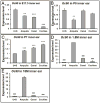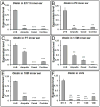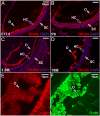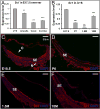Spatiotemporal differences in otoconial gene expression
- PMID: 27792272
- PMCID: PMC5914167
- DOI: 10.1002/dvg.22990
Spatiotemporal differences in otoconial gene expression
Abstract
Otoconia are minute biocrystals composed of glycoproteins, proteoglycans, and CaCO3 , and are indispensable for sensory processing in the utricle and saccule. Otoconia abnormalities and degeneration can cause or facilitate crystal dislocation to the ampulla, leading to vertigo and imbalance in humans. In order to better understand the molecular mechanism controlling otoconia formation and maintenance, we have examined the spatial and temporal expression differences of otoconial genes in the mouse inner ear at developmental, mature and aging stages using whole transcriptome sequencing (RNA-Seq) and quantitative RT-PCR. We show that the expression levels of most otoconial genes are much higher in the utricle and saccule compared with other inner ear tissues before postnatal stages in C57Bl/6J mice, and the expression of a few of these genes is restricted to the embryonic utricle and saccule. After the early postnatal stages, expression of all otoconial genes in the utricle and saccule is drastically reduced, while a few genes gain expression dominance in the aging ampulla, indicating a potential for ectopic debris formation in the latter tissue at old ages. The data suggest that the expression of otoconial genes is tightly regulated spatially and temporally during developmental stages and can become unregulated at aging stages. Birth Defects Research (Part A) 106:613-625, 2016. © 2016 Wiley Periodicals, Inc.
Keywords: RNA-Seq; aging; development; otoconial genes; spatial; temporal.
© 2016 Wiley Periodicals, Inc.
Figures







Similar articles
-
Matrix recruitment and calcium sequestration for spatial specific otoconia development.PLoS One. 2011;6(5):e20498. doi: 10.1371/journal.pone.0020498. Epub 2011 May 31. PLoS One. 2011. PMID: 21655225 Free PMC article.
-
Genes, manganese, and zinc in formation of otoconia: labeling, recovery, and maternal effects.Scan Electron Microsc. 1986;(Pt 4):1681-94. Scan Electron Microsc. 1986. PMID: 3810031
-
Saccule otoconia displacement into cochlea in cochleosaccular degeneration.Arch Otolaryngol. 1980 Mar;106(3):161-6. doi: 10.1001/archotol.1980.00790270025006. Arch Otolaryngol. 1980. PMID: 7356437
-
Otoconia in health and disease. A review.Ann Otol Rhinol Laryngol Suppl. 1984 Jul-Aug;112:17-24. doi: 10.1177/00034894840930s404. Ann Otol Rhinol Laryngol Suppl. 1984. PMID: 6431876 Review.
-
Mechanisms of otoconia and otolith development.Dev Dyn. 2015 Mar;244(3):239-53. doi: 10.1002/dvdy.24195. Epub 2014 Oct 18. Dev Dyn. 2015. PMID: 25255879 Free PMC article. Review.
Cited by
-
Involvement of Dmp1 in the Precise Regulation of Hair Bundle Formation in the Developing Cochlea.Biology (Basel). 2023 Apr 20;12(4):625. doi: 10.3390/biology12040625. Biology (Basel). 2023. PMID: 37106825 Free PMC article.
-
Increased Otolin-1 in Serum as a Potential Biomarker for Idiopathic Benign Paroxysmal Positional Vertigo Episodes.Front Neurol. 2020 May 13;11:367. doi: 10.3389/fneur.2020.00367. eCollection 2020. Front Neurol. 2020. PMID: 32477244 Free PMC article.
-
Retinoic acid signaling guides the efficiency of inner ear organoid-genesis and governs sensory-nonsensory fate specification.bioRxiv [Preprint]. 2025 Mar 21:2025.03.21.644434. doi: 10.1101/2025.03.21.644434. bioRxiv. 2025. PMID: 40166165 Free PMC article. Preprint.
-
Functional cooperation between two otoconial proteins Oc90 and Nox3.J Vestib Res. 2021;31(6):441-449. doi: 10.3233/VES-201591. J Vestib Res. 2021. PMID: 33554930 Free PMC article.
-
Whole-Genome Sequencing and Genome-Wide Studies of Spiny Head Croaker (Collichthys lucidus) Reveals Potential Insights for Well-Developed Otoliths in the Family Sciaenidae.Front Genet. 2021 Sep 30;12:730255. doi: 10.3389/fgene.2021.730255. eCollection 2021. Front Genet. 2021. PMID: 34659355 Free PMC article.
References
-
- Anniko M. Development of otoconia. Am J Otolaryngol. 1980;1:400–410. - PubMed
-
- Anniko M, Wenngren BI, Wroblewski R. Aberrant elemental composition of otoconia in the dancer mouse mutant with a semidominant gene causing a morphogenetic type of inner ear defect. Acta Otolaryngol. 1988;106:208–212. - PubMed
-
- Anniko M, Ylikoski J, Wroblewski R. Microprobe analysis of human otoconia. Acta Otolaryngol. 1984;97:283–289. - PubMed
MeSH terms
Substances
Grants and funding
LinkOut - more resources
Full Text Sources
Other Literature Sources
Medical
Molecular Biology Databases

